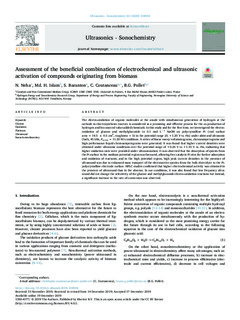| dc.contributor.author | Neah, N | |
| dc.contributor.author | Islam, Md. H. | |
| dc.contributor.author | Baranton, S | |
| dc.contributor.author | Coutanceau, Christophe | |
| dc.contributor.author | Pollet, Bruno | |
| dc.date.accessioned | 2020-01-15T08:51:38Z | |
| dc.date.available | 2020-01-15T08:51:38Z | |
| dc.date.created | 2020-01-14T04:39:29Z | |
| dc.date.issued | 2020 | |
| dc.identifier.issn | 1350-4177 | |
| dc.identifier.uri | http://hdl.handle.net/11250/2636326 | |
| dc.description.abstract | The electro-oxidation of organic molecules at the anode with simultaneous generation of hydrogen at the cathode in electrosynthesis reactors is considered as a promising and efficient process for the co-production of hydrogen and bio-sourced value-added chemicals. In this study and for the first time, we investigated the electro-oxidation of glucose and methylglucoside in 0.1 mol L−1 NaOH on polycrystalline Pt (real surface area = 14.5 ± 0.5 cm2, roughness ≈ 5) in the potential range [0; +1.20 V vs. rhe] under silent and ultrasonic (bath, 45 kHz, Pacous = 11.20 W) conditions. A series of linear sweep voltammograms, chronoamperograms and high-performance liquid chronoamperograms were generated. It was found that higher current densities were obtained under ultrasonic conditions over the potential range of +0.25 V to +1.10 V vs. rhe, indicating that higher oxidation rates were provided under ultrasonication. It was observed that the desorption of species from the Pt surface in the medium potential region was favoured, allowing free catalytic Pt sites for further adsorption and oxidation of reactants; and in the high potential region, high peak current densities in the presence of ultrasound was due to enhanced mass transport of the electroactive species from the bulk electrolyte to the Pt-polycrystalline electrode surface. HPLC studies confirmed that higher electrochemical activity was obtained in the presence of ultrasound than in the absence. In our conditions, it was also found that low frequency ultrasound did not change the selectivity of the glucose and methylglucoside electro-oxidation reactions but instead, a significant increase in the rate of conversion was observed. | nb_NO |
| dc.language.iso | eng | nb_NO |
| dc.publisher | Elsevier | nb_NO |
| dc.rights | Navngivelse 4.0 Internasjonal | * |
| dc.rights.uri | http://creativecommons.org/licenses/by/4.0/deed.no | * |
| dc.title | Assessment of the beneficial combination of electrochemical and ultrasonic activation of compounds originating from biomass | nb_NO |
| dc.type | Journal article | nb_NO |
| dc.type | Peer reviewed | nb_NO |
| dc.description.version | publishedVersion | nb_NO |
| dc.source.journal | Ultrasonics sonochemistry | nb_NO |
| dc.identifier.doi | 10.1016/j.ultsonch.2019.104934 | |
| dc.identifier.cristin | 1771938 | |
| dc.description.localcode | © 2019 The Authors. Published by Elsevier B.V. This is an open access article under the CC BY license (http://creativecommons.org/licenses/BY/4.0/). | nb_NO |
| cristin.unitcode | 194,64,25,0 | |
| cristin.unitname | Institutt for energi- og prosessteknikk | |
| cristin.ispublished | true | |
| cristin.fulltext | original | |
| cristin.qualitycode | 1 | |

